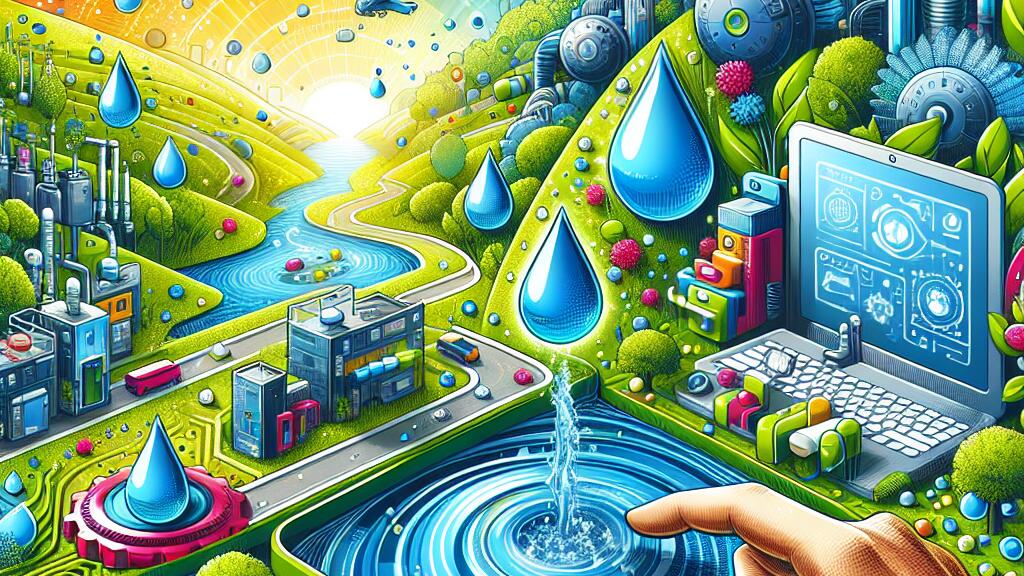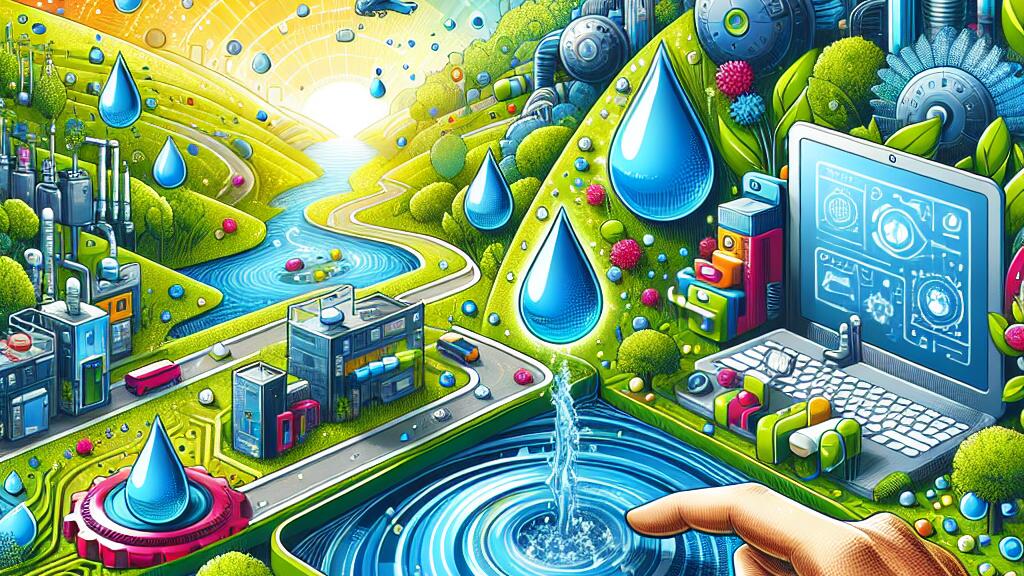Table Of Contents
Exploring the Role of Technology in Water Conservation and Innovative Water Conservation Technologies
Key Takeaways
- Comprehending the significance of saving water
- The function of innovation in preserving water
- Essential tactics for water preservation
- Sophisticated tracking and control systems
- Involvement of the community and awareness initiatives
Understanding Water Conservation
Water conservation is a critical aspect of sustainable water resource management, addressing the ever-growing challenges of water scarcity and pollution. Effective water utility strategies incorporate advanced water technologies that enhance water efficiency across various sectors. By optimizing water infrastructure, communities can improve their water-use practices while reducing waste. Innovations such as smart irrigation systems and water-saving devices play a significant role in conserving water and ensuring that this vital resource is available for future generations. The Role of Technology in Water Conservation is increasingly vital, as it empowers individuals and organizations to monitor their water usage and implement effective measures that promote responsible water management. Through community engagement and education, the adoption of these technologies can lead to meaningful changes in how society approaches water conservation.

Importance of Sustainable Water Management
Sustainable water management is essential for addressing the growing challenges posed by the global water crisis. Effective water policy incorporates strategies to optimize public water supplies while minimizing water consumption. By focusing on reducing water footprints and enhancing water availability, communities can better manage their water resources. Water supply systems must adapt to meet the needs of both urban and rural populations, ensuring that all have access to clean and safe water. Innovations in water recycling and water reuse further bolster efforts to conserve water, contributing to a balanced approach to resource management.
The Role of Technology in Water Conservation is pivotal in creating efficient systems for monitoring and managing water content. Smart technologies enable precise control over water supply systems, promoting better practices in conserving water across various sectors. By leveraging data analytics and remote sensing technologies, stakeholders can gain insights into water usage patterns and identify areas for improvement. Investment in these technological advancements supports not only the enhancement of public water supply but also encourages the sustainable management of water resources in India and beyond.
The Global Water Crisis
The ongoing global water crisis highlights significant challenges in maintaining water quality and availability. Many regions face severe water shortages, exacerbated by inefficient water supply networks and widespread water waste. Conservation efforts must adapt to integrate water resource management effectively. Technology’s role in water conservation is crucial, providing innovative solutions to improve water retention and ensure the safe distribution of clean water. Addressing the dual issues of water damage and the diminishing water supply can bolster water security for communities worldwide.
Communities around the globe are experiencing varying degrees of the water crisis, leading to increased awareness about the importance of sustainable practices. Effective management strategies are needed to minimize water wasted and enhance the efficiency of existing water supply networks. Utilizing technology can assist in monitoring water usage and identifying leaks within these systems, thus mitigating negative impacts. The integration of advanced tools in conservation efforts not only ensures the availability of clean water but also promotes responsible water stewardship essential for future generations.
The Role of Technology in Water Conservation
Technological advancements play a crucial role in addressing water stress and enhancing sustainable water management. By implementing innovative water conservation technologies, communities can effectively minimize waste water and combat issues such as water contamination and waterlogging. Devices like smart water tanks and automated water-harvesting systems contribute to efficient water cycle management, ensuring that every drop is utilized. Technologies that promote watersense practices empower users to adopt water conservation strategies that align with their conservation aims. As the role of technology in water conservation evolves, it provides vital tools for implementing effective water conservation practices, ultimately supporting a more sustainable future.

Innovations in WaterSaving Devices
The development of water-efficient technologies plays a crucial role in reducing overall water consumption. Many water conservation programs now leverage new water technologies to promote robust water conservation practices. These technologies include smart faucets, low-flow showerheads, and efficient irrigation systems that drastically cut down water usage without sacrificing performance. By integrating such conservation technologies into daily life, individuals and communities can adopt effective water conservation measures that support sustainable water usage.
The Role of Technology in Water Conservation also extends to devices that assist in monitoring water use. Control technologies water, such as automated leak detection systems and smart meters, provide real-time data on water consumption patterns. This information empowers water conservation campaigns by enabling users to identify areas where adjustments can lead to significant water conservation. The implementation of these innovative solutions is supported by organizations like the USEPA Water Conservation, which advocates for practices that ensure the responsible management of this vital resource.
Smart Irrigation Systems
The integration of technology into irrigation practices promotes sustainable water use by optimizing water application. These systems assess weather conditions, soil moisture levels, and plant needs in real time, allowing for precise water distribution. By ensuring that crops receive the right amount of water at the right time, they contribute to effective water management and enhance the usability of available water resources. This approach not only addresses current water management challenges but also aligns with sustainable water practices aimed at preserving water resources.
By harnessing data analytics and automated controls, these innovations tackle global water challenges through improved agricultural efficiency. Farmers can reduce water usage significantly while still maintaining crop yields, showcasing an effective strategy for addressing water-related challenges. This method reflects the broader movement toward sustainable water management that incorporates modern technology, providing a pathway to mitigate the impacts of climate change on global water availability. The Role of Technology in Water Conservation is pivotal for developing solutions that adapt to varying conditions while safeguarding our vital water resources.
Key Water Conservation Strategies
Effective water conservation hinges on implementing strategic methods that promote efficient water use while addressing community and environmental needs. Embracing The Role of Technology in Water Conservation can lead to innovative solutions like rainwater harvesting techniques and greywater recycling systems, which enhance water utilization and ensure an adequate supply for various water-related activities. These methods not only contribute to saving water but also align with the demand for smart water management practices. Water utilities and companies benefit from adopting such strategies as they help maintain optimal water levels and improve water quality protection. By focusing on efficient water management, communities can foster sustainable practices that meet their water needs without compromising future resources.
Rainwater Harvesting Techniques
Rainwater harvesting plays a pivotal role in the conservation of precious water resources. This technique involves collecting and storing rainwater for later use, significantly reducing reliance on traditional water supply systems. Various technologies help minimize water use through efficient capture and storage solutions. By integrating these methods into water management practices, communities can achieve significant water savings, addressing the unprecedented water challenges faced globally. This approach not only aids in recycling water but also facilitates effective water-use regulation.
Incorporating advanced technologies further enhances the effectiveness of rainwater harvesting systems. AI-enhanced water management initiatives can monitor water levels in real-time, ensuring optimal use and avoiding waste. These tools deliver essential data regarding detailed water usage patterns, which helps to protect water quality and efficiently manage resources. Adopting such innovative solutions is crucial in navigating the water problem while also fostering sustainable practices that align with the essential role of technology in water conservation.
Greywater Recycling Solutions
The implementation of greywater recycling systems plays a vital role in addressing the water quality challenges faced by many communities. These systems treat and reuse water from sinks, showers, and washing machines, greatly reducing high water usage and supporting conservation practices. With the help of water-saving appliances, households can substantially lessen their environmental footprint. Through advanced water management software, these systems can also be monitored effectively, ensuring they contribute positively to a healthy water environment while meeting the growing water demand in a water-conscious society.
Innovative greywater recycling solutions represent a crucial aspect of sustainable water management in the face of ageing water infrastructure and vast water consumption. By incorporating these systems, communities can engage in effective conservation efforts, paving the way for a water-wise future. This technology not only mitigates the strain on existing resources but also addresses various water quality concerns by ensuring that recycled water is safe for non-potable uses. Such initiatives demonstrate The Role of Technology in Water Conservation, showcasing practical methods to adapt to changing conditions and enhance overall water sustainability.
| System Type | Application | Water Savings (Liters/Day) | Installation Cost (USD) |
|---|---|---|---|
| Residential Greywater Systems | Bathroom and Laundry | 200 | 1,000 – 3,000 |
| Commercial Greywater Systems | Hotels and Restaurants | 1,000 | 5,000 – 10,000 |
| Advanced Treatment Systems | Public Facilities | 5,000 | 20,000 – 50,000 |
| Decentralized Greywater Systems | Community Use | 500 | 8,000 – 15,000 |
Advanced Monitoring and Management Systems
Advanced monitoring and management systems play a critical role in the effective conservation of freshwater resources. By utilizing technology, these systems provide insights into water usage patterns, allowing for more informed decisions in water demand management. The ability to accurately assess water usage not only helps in optimizing the consumption in water-intensive industries but also ensures that basic water services are maintained for communities. Through the collection of data, stakeholders can enhance the management of natural water bodies, contributing to improved water quality and the preservation of natural water reserves. By implementing water-sensitive design approaches, local water use can be aligned with the natural water cycle, promoting sustainability. This innovative technology ultimately supports the broader objective of conserving available freshwater supplies for future generations.
Remote Sensing Technologies
Remote sensing technologies play a pivotal part in advancing water conservation efforts. They enable the monitoring of water tank levels, aiding in the detection of water leaks that can lead to significant losses of precious water. Utilizing these technologies, municipalities can assess water quality characteristics and better understand residential water consumption patterns. This data is crucial for formulating a national water policy aimed at promoting equitable water use and reducing water-associated costs.
These technologies empower both individuals and communities to achieve optimal water usage. By analyzing water samples and leveraging tools like water scrooge™ leak detection systems, users can identify inefficiencies and prevent water mismanagement. This proactive approach not only conserves resources but also contributes to a water-secure future. Embracing the role of technology in water conservation is essential for fostering sustainable practices in residential water use and ensuring the health of our ecosystems.
Data Analytics in Water Use
Data analytics plays a crucial role in addressing the challenges of industrial freshwater consumption and domestic water economy. By utilizing advanced techniques like water accounting, stakeholders can monitor and evaluate water quantity throughout various treatment processes. This approach helps to identify areas of water losses and enhances the efficiency of systems designed to purify water. With the integration of nature-based technology, industries can achieve an optimum water supply while also managing water flow effectively.
The ability to implement precise water delivery systems can significantly reduce the need for non-potable water in various applications. Water-economy washers equipped with smart features can leverage data analytics to optimize water usage, thereby conserving vital resources. By analyzing patterns and trends, organizations can adapt their water treatment processes to ensure adequate water is available, promoting sustainable practices across sectors. The Role of Technology in Water Conservation becomes increasingly evident as these tools empower users to make informed decisions that will benefit the environment and society.
- Improved monitoring of water usage helps in early identification of leaks and inefficiencies.
- Data-driven insights enable targeted interventions for conservation efforts.
- Automation of water delivery systems reduces wastage and enhances reliability.
- Predictive analytics can forecast water demand, aiding in better resource planning.
- Integration of IoT devices allows for real-time data collection and analysis.
- Sustainable practices lead to lower operational costs and increased compliance with regulations.
- Collaborative platforms for stakeholders can foster sharing of best practices and innovations in water management.
Community Engagement and Education
Engaging communities in water conservation efforts is essential, especially in areas facing high water stress and issues such as excessive water consumption. The role of technology in water conservation can be exemplified through the use of innovative tools like the Water Scrooge™ app, which enables users to monitor their water flow and volume effectively. This app not only provides insights into potential water leaks but also encourages the adoption of water-saving fixtures, supporting inclusive water governance. Community programs can also promote the use of conservation tillage equipment and smart water grids to optimize capita water availability. Initiatives like the Cascade Water Alliance exemplify how technology can facilitate engagement, helping communities manage surplus water and preserve resources more sustainably through collective action.
Mobile Apps for Water Conservation
Mobile applications have emerged as powerful tools in the quest for effective water conservation. These apps allow users to monitor water quality parameters and overall water consumption efficiently. They can also integrate with smart water meters and irrigation control technology to optimize water distribution. Innovative features enable tracking of water flow management, ensuring users can manage water risers effectively, especially in water-rich regions facing clean water shortages. With functionalities like alerts for water-harvesting measures, individuals are empowered to make informed decisions about how they use and conserve water.
Many apps focus on sustainable groundwater management, providing insights into how daily activities impact this vital resource. Users can engage with rotary spray heads that deliver water in a thicker stream, which enhances irrigation efficiency. Through data analysis, the apps educate users on optimizing water consumption and implementing better conservation practices within their homes. This blend of technology and community involvement plays a crucial role in fostering a culture of responsibility regarding water use and conservation strategies.
- Educate users on the importance of water conservation practices.
- Provide real-time data on household water usage.
- Offer reminders for scheduled water management tasks.
- Allow users to set conservation goals and track progress.
- Facilitate community challenges to motivate collective water-saving efforts.
- Recommend personalized irrigation schedules based on local weather conditions.
- Highlight tips for reducing water usage in everyday activities.
Conclusion
Understanding the critical importance of sustainable water management reveals the severity of the global water crisis. Massive water losses occur across various sectors, significantly impacting our waterways and overall ecosystem health. Household water consumption remains a primary focus, with innovative solutions like water scrooge™ offering practical and efficient ways to conserve this vital resource. The Role of Technology in Water Conservation cannot be understated, as advancements such as smart irrigation systems and water-saving devices play a pivotal role in mitigating waste and ensuring responsible usage. By integrating technology into our daily routines, communities can significantly reduce their environmental footprint and promote a culture of conservation for future generations.
FAQS
How does technology empower water conservation and what are some modern water management activities that it incorporates?
Technology empowers water conservation by integrating innovative solutions such as water conservation technology and wireless water tanks. These advancements aim to optimize water distribution and manage water flow effectively, ensuring efficient water usage. Additionally, technology helps in identifying possible water leaks, allowing water companies to reduce water pollution and manage water volume accurately. By utilizing tools like rotary spray heads that deliver water in a thicker stream, we can optimize water consumption and enhance water conservation ways. The water scrooge™ offers unique features that further support these efforts in water conservation aims.
How can innovative water technologies help in optimising water distribution and ensuring the availability of usable water?
Innovative water technologies play a crucial role in optimising water distribution by incorporating modern water management activities that integrate water resource management. For instance, advancements such as rotary spray heads deliver water in a thicker stream, which aids in accurate water application while supporting water level reduction strategies. The integration of these technologies ensures that communities can effectively manage their water resources while maximizing the availability of usable water.
How does an innovative water tank integrate water resource management to optimise water distribution in conservation efforts?
An innovative water tank integrates water resource management by efficiently collecting, storing, and distributing water. This technology plays a crucial role in optimising water distribution, ensuring that water conservation efforts are effective. By utilizing smart sensors and automated systems, these tanks help track water usage and reduce waste, ultimately leading to more sustainable water conservation practices.
What strategies can be employed to optimise water distribution using modern technologies?
Employing strategies such as smart irrigation systems, real-time monitoring of water use, and predictive analytics can significantly optimise water distribution. These technologies enable more efficient management of resources, leading to reduced waste and better overall conservation efforts.
What are the benefits of implementing smart irrigation systems in water conservation efforts?
Smart irrigation systems play a crucial role in water conservation by efficiently managing water distribution. They utilize technologies such as soil moisture sensors and weather data to optimize irrigation schedules. By automating the watering process, they ensure that plants receive the right amount of water at the right time, which leads to reduced water waste and improved conservation outcomes. Additionally, these systems can adjust to real-time environmental conditions, further enhancing their effectiveness in sustainable water use.

